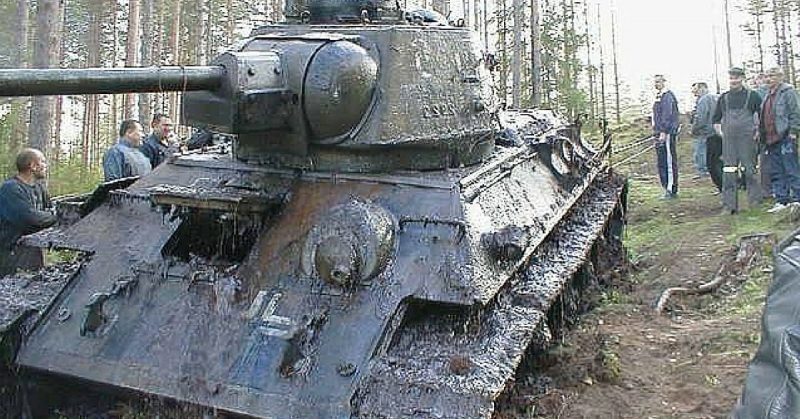During the Second World War, German soldiers made the surprising decision to deliberately drive a tank into a marshy lake and then abandon it. However, there is definitely more to this story, as the tank in question was actually built by the Russians.
The T-34 was a prime element of Soviet forces during the war, and holds an important place in the history of tanks and the technology behind them. When it was first designed and constructed, it was unmatched in its even balance of strength, maneuverability and firepower. Combined with its versatility on a wide range of terrain, this was a truly ground-breaking and innovative machine.
Of course, it was eventually made redundant as more modern designs outmatched it in later years. However, the original T-34 is still remembered as an important link in the chain of tank development. In fact, many have hailed it as the best example of its kind from the entirety of the Second World War.
Because of its outstanding design, T-34s were able to be refined continuously, so as to meet the changing requirements found throughout the Eastern front. As a result, they grew more effective and capable the longer the war went on, while also becoming steadily cheaper and easier to produce.
Eventually, 80,000 of the tanks, in their various incarnations, would be produced by the Soviets. This allowed them to field steadily increasing numbers of the T-34s despite losing thousands on the battlefield.
In eastern Estonia, the 50 kilometres wide Narva Front was the scene of fierce battles fought between February and September, in 1944. The country had originally declared itself as neutral in the conflict, but as time went on it had fallen increasingly under the influence of the Soviet Union. Eventually it was occupied by Russian forces, becoming the scene of some truly deadly battles. An estimated 100,000 men were killed and more than 300,000 were wounded throughout this period.
During this time, German forces captured a T-34 and started using it as their own. Of course, Hitler’s attempts to defeat the Soviets and conquer Russia proved to be a colossal failure, and ultimately one of the defining elements in his overall defeat in Europe. It is thought that the Germans who had commandeered the vehicle must have been retreating, and did not want their tank to be retaken and used again by the advancing Soviet Army.
So it was that one of the best tanks built during the Second World War was abandoned in an Estonian lake. It settled in twelve feet of water, before six more feet of peat and silt covered it.
Years later, this particular T-34 was rescued from its watery grave, and given a second lease of life. The low oxygen levels in the marshy bog meant that the metal with which the tank was constructed did not corrode as fast as it might have in other conditions, and so the majority of the machine was relatively well preserved.
During a two week period, volunteers from a local diving club washed the silt and mud from the tank. Then, with the aid of a tractor, they managed to pull it to the shore. There the tank’s ammunition – 116 pieces – was carefully removed.
This mighty Soviet war machine was then taken to a museum in the village of Gorodenko. Incredibly, even after its time in the marsh, they were able to start the T-34’s diesel engine without needing any spare parts.
The restoration of the tank was completed in 2007, and it is now on display at that same war museum. In this video, viewers can witness the very moment it leaves the water, and the surprise and joy of the bystanders as this tank emerges from the lake for the first time in 60 years.
https://www.youtube.com/watch?v=YNJ-acc9Qsk
